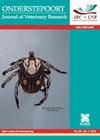Comparison of Commercial Enzyme-linked Immunosorbent Assays for Diagnosis of Contagious Agalactia Caused By Mycoplasma Agalactiae
IF 1.6
3区 农林科学
Q2 VETERINARY SCIENCES
引用次数: 0
Abstract
Abstract Introduction Contagious agalactia (CA) is a disease affecting small ruminants with worldwide distribution and caused by several mycoplasmas, especially M. agalactiae. The main option for systematic diagnosis under monitoring control programmes is the enzyme-linked immunosorbent assay (ELISA) test. Material and Methods This study was designed to appraise the performance of two commercial indirect ELISA tests using M. agalactiae p48 protein and one using total protein, for antibody detection in small ruminants after natural infection with different M. agalactiae strains. We carried out the test evaluation using sera of confirmed M. agalactiae-positive goats with clinical signs. In addition, test agreement was assessed by kappa between the three commercial ELISA tests. Results All three ELISA tests showed high validity scores (Youden’s J: 72.9–84%). The sensitivity values for the P48 protein-based tests were 76.9% and 84.6%, and was 79% for the total protein-based test. The specificity of all tests was 100%. In addition, between the total protein-based ELISA test and the other two ELISA tests based on the P48 protein, the agreement was substantial (kappa: 0.762–0.763) and the agreement between the latter two tests was almost perfect (kappa: 0.93). Conclusion The validity parameters for all tests allowed their application for diagnostic purposes in lactating goats excreting M. agalactiae in milk and presenting clinical signs. The agreements show that any of these ELISA tests could be equally well used for diagnosis in programmes against CA.商用酶联免疫吸附法诊断无乳支原体致传染性无乳的比较
摘要简介传染性无乳病(CA)是一种分布在世界各地的小反刍动物疾病,由几种支原体,尤其是无乳支原体引起。在监测控制规划下进行系统诊断的主要选择是酶联免疫吸附试验(ELISA)。材料与方法本研究采用两种商业化间接ELISA法分别检测无乳支原体p48蛋白和总蛋白对小反刍动物自然感染不同无乳支原体菌株后抗体的检测效果。我们使用临床症状确诊的无乳分枝杆菌阳性山羊的血清进行测试评估。此外,用kappa法评估了三种商用ELISA检测的一致性。结果3项酶联免疫吸附试验的效度均较高(约登J值:72.9 ~ 84%)。P48蛋白检测的敏感性分别为76.9%和84.6%,总蛋白检测的敏感性为79%。所有检查的特异性均为100%。此外,基于总蛋白的酶联免疫吸附试验与基于P48蛋白的其他两种酶联免疫吸附试验之间的一致性很好(kappa: 0.762-0.763),后两种酶联免疫吸附试验之间的一致性几乎是完美的(kappa: 0.93)。结论所有试验的效度参数均可用于诊断泌乳山羊在乳中排泄无乳乳杆菌并出现临床症状。这些协议表明,这些酶联免疫吸附试验中的任何一种都同样可以很好地用于诊断针对CA的规划。
本文章由计算机程序翻译,如有差异,请以英文原文为准。
求助全文
约1分钟内获得全文
求助全文
来源期刊
CiteScore
4.30
自引率
0.00%
发文量
13
审稿时长
16 weeks
期刊介绍:
The Onderstepoort Journal of Veterinary Research, is the official publication of the Onderstepoort Veterinary Institute. While it considers submissions from any geographic region, its focus is on Africa and the infectious and parasitic diseases and disease vectors that affect livestock and wildlife on the continent.

 求助内容:
求助内容: 应助结果提醒方式:
应助结果提醒方式:


